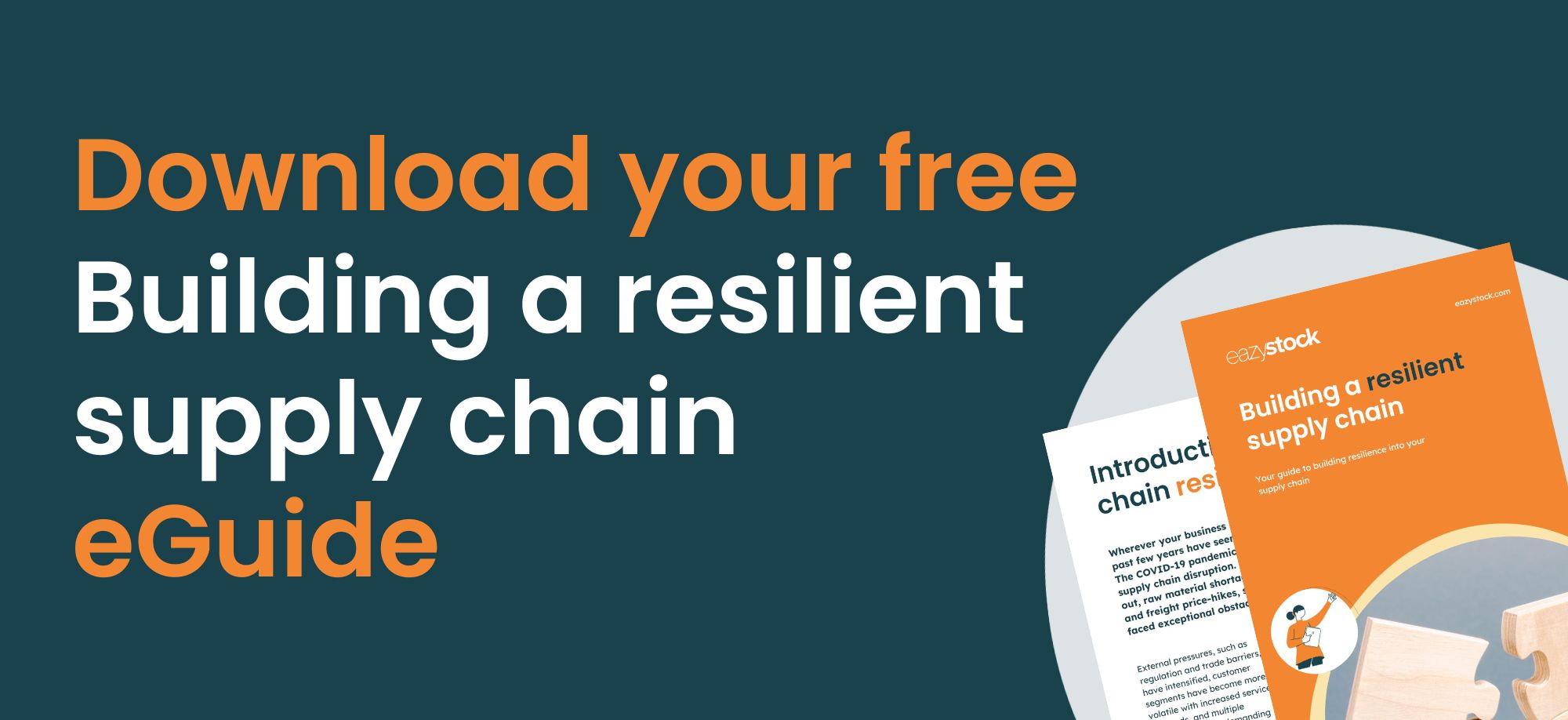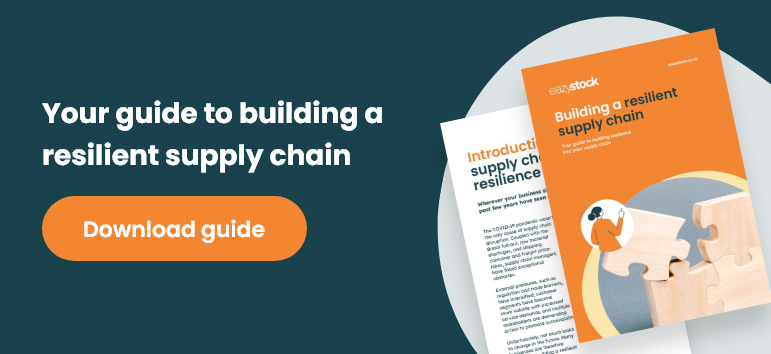Improving inventory planning during supply chain disruption
This post focuses on inventory planning and optimising stock levels during periods of supply chain disruption and erratic customer behaviour.
Let’s start with understanding inventory planning.
Stock-holding businesses can’t get away from needing to hold items to meet customer demand, but inventory can account for up to an eye-watering 80% of a company’s cash. Holding too little stock can lead to stockouts and missed sales opportunities, but having too much affects cash flow and ties up money that could be invested elsewhere.
Inventory planning is the process of forecasting demand to understand exactly how much stock you need to order and when. When done well, inventory planning processes can help companies meet demand and reduce inventory costs to maintain a healthy bottom line.

While we’ve come through some tough years of supply chain disruption, there’s still a lot of uncertainty as we see a continual stream of global events that affect supply and demand. These could lead to continual global supply chain disruptions affecting the supply of raw materials and finished items. Therefore, inventory planners and inventory management teams must have inventory management processes that overcome the following challenges.
- How to regularly review demand forecasts and understand demand patterns for each of their inventory items.
- Businesses must identify the stock items critical to their business, which will vary depending on whether you are a manufacturer or supplier. For example, critical items for manufacturers will prevent production stoppages. In contrast, critical items for suppliers, distributors and retailers will usually be their best-selling products or those with the most significant margin.
- How to prevent excess stock from piling up in the warehouse.
- How to monitor stock levels at each stage of the supply chain and ensure every item is put to best use.
- How to keep stock investment as low as possible to free up working capital without negatively impacting service levels (stock availability) and customer satisfaction.
If you’re grappling with the challenges above and wondering how you can improve inventory management to find that magic balance of holding enough stock to meet demand while not tying up working capital unnecessarily, it’s time to consider inventory optimisation.
Inventory planning and inventory optimisation have the same goal: keep stock levels and capital investment as low as possible while being able to meet demand. With the right inventory optimisation software, you can keep your customers, finance team and board members happy.
Let’s look at how inventory optimisation can support your inventory planning processes.
Data analysis and demand forecasting
If you’re struggling with lost sales thanks to stockouts or trying to figure out how to sell off obsolete and excess stock, your demand forecast might need reviewing. Accurate demand forecasts are fundamental to getting the right inventory when and where you need it. Fundamental to getting accurate demand forecasts is accurate inventory data.
Review your inventory management processes to understand your forecasting techniques if you haven’t already. Managing hundreds or thousands of SKUs is challenging enough, but if you’re still using spreadsheets, they can’t provide much more than historical sales and inventory data. If you’re basing your forecasts on a 30-day rolling average, you’re missing out on demand trends and market changes. Spreadsheets also make it hard to understand which items you should prioritise.

Read our demand forecasting techniques blog to understand how the advanced algorithms of inventory optimisation software can make forecasting a breeze.
Safety stock calculations
Getting your forecasts as accurate as possible is vital, but without a crystal ball, we cannot be 100% certain, especially in these times of uncertainty. That’s where safety stock comes in. Safety or buffer stock is extra stock that can cover unexpected demand surges once you use your regular cycle stock.
There are several safety stock calculations, but they can be insufficient when dealing with supply and demand challenges. Rather than calculate safety stock levels manually using basic statistic formulas, you can take advantage of the complex calculations available through inventory optimisation software.
Download our free How to calculate safety stock for inventory management eGuide, which explains safety stock and safety stock calculations in more detail.
Identify and manage critical stock
When supply is restricted or lead times are unreliable, it’s essential to identify stock items critical to your business and build an inventory plan to alleviate the risk of stockouts. At the same time, investing in stock that will generate revenue, not sit in your warehouse, and potentially become obsolete is important.
Many inventory planning teams will use a simple stock classification model, such as ABC inventory analysis, to categorise inventory based on each item’s value to the business. Using the Pareto principle, 80% of sales will come from 20% of your inventory, so it makes sense to identify items that comprise that 20% and set stocking policies to help secure their supply.
However, manual ABC inventory analysis dates quickly. It also takes time, which your team might not have.
Inventory optimisation software automates the process and analyses every SKU before classifying it based on a more comprehensive range of criteria, such as cost of goods sold, pick rate, demand volume and demand volatility.
EazyStock can categorise stock into over 200 segments before applying stocking rules, which are configured during implementation and manually adjustable based on what’s happening in your market.
This more advanced, multi-dimensional classification model and inventory policies allow you to optimise stock levels to ensure high service levels, e.g. stock availability.
Generally, items with consistent demand and a low cost to sell will have high service levels, whilst those that are expensive to stock with inconsistent sales will have lower service levels. However, if these latter items are also critical to your business, you can flag them in a critical items list and assign appropriate stocking rules.

EazyStock dynamically updates your ‘inventory matrix’ daily, moving items between categories and automatically updating inventory policies when required. You have automatically optimised inventory levels that allow your business to invest in the right stock items, keep stockouts to a minimum and reduce the risk of excess inventory.
You can read more about ABC analysis in our blog.
Supplier planning
Suppliers are pivotal to being able to meet your targets. You can’t meet customer demand if you can’t get the supply you need. If you’re regularly reviewing your suppliers, you’ll know that they vary depending on cost, lead times, quality, reputation, and minimum order quantities (MOQ).
You should take the time to build strong relationships with your suppliers so that you can turn to them when you need rush orders, prioritisation, or special rates. Keeping track of the various requirements can be tricky if you’re trying to sort through lots of paperwork or spreadsheets to find the information every time you want to place an order.
Inventory optimisation software like EazyStock can make this much easier and mitigate the risks of supply delays due to any disruption. Enter supplier details into the system, and EazyStock will select the best supplier to meet your order by considering the supplier variables.
You can also take advantage of supplier calendars to adjust lead times, reorder points, order quantities and safety stock levels depending on factory shutdowns, such as Chinese New Year.
Understanding the impact of inventory investment on order fulfilment
Your inventory planning processes should include replenishment strategies. A common challenge for many inventory planning teams is looking for ways to reduce investment tied up in inventory without reducing order fulfilment rates or service levels.
EazyStock’s target service level simulation tool helps you understand the relationship between your inventory investment and service levels. It allows you to simulate investment adjustments to see the potential impact on your service levels. Conversely, you can understand how increases or decreases in service levels will deliver savings or inflate costs. This helps you use your cash wisely, understand business implications and plan for change.
Warehouse analysis
Identifying and using surplus stock along your supply chain is one way to help alleviate the pressure on supply and could be the difference between business continuity and grinding to a standstill.
Many companies will have surplus or excess stock. This could be finished goods reserved for customers who no longer need them, excess inventory sitting in satellite warehouses, obsolete goods superseded by newer models, spare parts, or items held by suppliers/stores not currently trading. If you’re a global distributor, you may also find you have excess stock in some countries while other locations are booming.

While a good warehouse management system (WMS) or enterprise resource planning (ERP) platform will tell you how much of every stock item you hold in your warehouse, EazyStock can take this one step further. By identifying which stock items are needed to satisfy upcoming demand and what is excess, you can move stock around to help prevent stockouts.
EazyStock can also redistribute stock automatically. For example, when confirming an order, it can recommend stock redistribution instead of ordering from a supplier, which is often more economical.
Continual inventory and demand forecasting monitoring
Once you have your inventory management policies in place, don’t forget to check them regularly. While they might be right at the time you set them, in times of uncertainty, things can change quickly. Modern inventory management processes and inventory optimisation software can help you quickly respond to market changes to ensure you minimise disruption.
Smart inventory planning with inventory optimisation software
At a time when cash is a precious commodity for most businesses, optimising stock levels is an important way to release working capital and protect the bottom line. Trying to do this manually with spreadsheets or using your WMS or ERP system is challenging at the best of times. With supply and demand so unpredictable and internal resources pushed to their limits, it’s almost impossible.










